This is a
recipe I learned in a cooking class at Philadelphia’s famous DiBruno Brothers.
It’s surprisingly easy, much easier than regular gnocchi. It will take about 30
to 45 minutes to make a whole batch of gnocchi, and about 10 minutes more to
have a finished dinner on the table (provided you made your sauce in
advance). Each batch should be about 5 servings.
Ricotta Gnocchi:
1 lb. fresh
ricotta
1 large egg
1 tablespoon extra-virgin
olive oil
2 teaspoons salt
4 oz. (scant
cup) flour, plus extra for work surfaces
First and
foremost: let’s talk ricotta. If you happen to live near a fancy-pants Italian
cheese shop, see if they have ricotta del pastaio – it has a lower water
content than the regular stuff from the grocery store, which makes it better
for things like pasta and gnocchi. If all you have access to is the stuff in
the grocery store that comes in the plastic tubs, place a strainer over a bowl
and line with cheese cloth/paper towels. Place the ricotta on the cloth, cover,
and let it sit in the fridge overnight. Now, I’ve used regular ricotta in the
past and skipped this step with fine results, so if you’re crunched for time
you can get away with not draining the excess moisture – just try not to add
too much extra flour when making the gnocchi.
Ok, now that our
ricotta situation is under control, let’s get to the recipe. Beat the egg with
a whisk and add to a bowl along with the ricotta, olive oil and salt. Mix to
integrate. Form a well in the center and add the flour, slowly integrating with
the cheese mixture until a dough forms. You may need to add a little extra
flour – the dough should be a little tacky, but not sticky.
Cut the dough
into six equal sized pieces, covering the parts you’re not using with plastic
wrap. On a lightly floured surface, work each piece into a cigar shape, rolling
from the center outwards. Each rope shaped piece should be about ½ - ¾” thick.
Cut each rope into 1” long pieces.
Once cut, pinch
off the ends of each gnocchi, and place on a baking tray lined with parchment
paper and lightly floured. If you’re not planning to cook the gnocchi the same
day, place the baking sheet in the freezer. Once frozen, place the gnocchi into
a large Ziploc bag.
To cook the
gnocchi, bring a pot of salted water up to a light boil. Add in the gnocchi,
give the water a stir (so they don’t stick to the bottom) and cook for 1 minute
(if fresh) to 3 minutes (if frozen) until they float to the top of the pot.
Remove from the pot.
Tomato sauce:
This is more a
general guide to how I do it than a real recipe per se. Open up a 6 lb. can of
whole peeled tomatoes (I use Cento Italian Peeled tomatoes. San Marzanos are a
really good choice, but I think they’re just too expensive, personally.), and
add half to a blender. Puree to a liquid, and add into a large pot. Add the
other half to the blender, and pulse a few times until broken down, but not so
much that they don’t have any texture. I don’t like my tomato sauce chunky, but
if you do you can just add the tomatoes to the pot whole, and break them up
with a wooden spoon/potato masher to desired consistency while they cook down.
Add a large
onion, peeled and chopped in half into the tomatoes. Yes, two giant halves and
not diced onions. This trick comes from Marcella Hazan, and allows you to have
that great onion flavor in your sauce without having to pick out onion bits
from your teeth. Add to that some crushed cloves of garlic (4 or 5), a
tablespoon of sugar, some salt, some dried oregano, and a little dried basil
(not too much, as we’ll be adding fresh basil when serving), and crushed red
pepper (not too much, as it will intensify as the sauce cooks down.
The sauce will
taste under-seasoned, and very tomato-like. This is fine, as all those flavors
will be picked up once the sauce cooks. Bring the sauce up to a boil, reduce to
a simmer, and allow to simmer, uncovered, for an hour. Taste, and add
seasonings as you see fit. The sauce should start to taste a little more like
the finished product, but we still have some reducing to do. Simmer for another
hour, or until the consistency looks good to you. Remove the onion and adjust
seasonings as needed.
Putting it all together (for 1 serving):
1/3 lb.
luganega, or other Italian sausage
½ tablespoon olive oil
½ cup prepared
tomato sauce
1 tablespoon
reserved pasta water
Parmesan cheese
Fresh basil
Extra-Virgin
Olive Oil (the good stuff!)
Cut your sausage
into ¾” thick pieces. Pre-heat a 10” frying pan over medium heat. Add in about ½
tablespoon of olive oil and the sausages, cooking on each side. If there is too
much excess grease in the pan once the sausages are cooked, remove the sausages
and drain the grease. Add the sausages back into the pan along with the ½ cup
of prepared tomato sauce. Make sure the heat isn’t too high, as the sauce will
heat quickly and possibly splatter.
Add the cooked
gnocchi to the sauce along with 1 tablespoon of the water they were cooked in.
Toss, and transfer to a bowl, topping with parmesan, fresh basil, and a little
extra virgin olive oil.




















